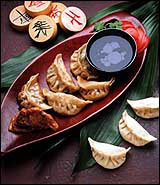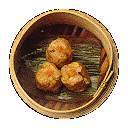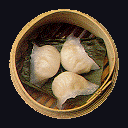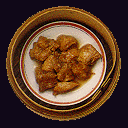
Today's Special
For the Chinese 'yum cha' or eating dim sum is not only a daily form of food consumption or an occasion to spend time with your family, establish a business relation and experience social congeniality, it is also an idiom of social existence. Dim Sum is mostly taken for breakfast or for lunch and Sundays are exceptionally popular for a family lunch or breakfast. On those days you have to arrive early or know someone at the Dim Sum Restaurant if you do not want to queue for hours waiting for a table. Although it is very noisy in the restaurant and many have to queue for a long time to get a table, the Cantonese still loves it. Some parent even send their children to queue for a table for the family a couple of hours in advance on Sunday...
Cooking Dim Sum

What Is Dim Sum?
Dim Sum means "little heart" or "touch your heart" - an apt reference to these little dishes that both delight the palate and captured the imagination. Dim Sum is Cantonese cuisine that comes mainly in the form of steamed and fried dumplings containing a wide array of mouth-watering fillings. The quantity of each dish in dim sum was kept small - the delicacies were served in tiers of bamboo steamers or small to medium-sized plates - so that many different varieties could be sampled: crisp croquettes, translucent dumplings, sticky cakes, fried rice, etc.
Dim Sum and Tea
Long before the Spanish created tapas and the Americans discovered finger foods, the Southern Chinese were gathering for 'yum cha' (tea) and sampling savory morsels known as Dim Sum. The custom of tea drinking in China dates back to the legendary Shen Nung, who is said to have personally tried hundreds of grasses and herbs to test their medicinal effects and toxicity. Tea was a popular drink by the Sung Dynasty (960-1280 A.D.), and gradually, innovations in the tea drinking custom were introduced. In addition to a high level of connoisseurship of the various types of tea and improvements in the quality of tea leaves, a broad variety of accompaniments to tea drinking began to appear - Dim Sum.


Eating Dim Sum Today
In today's China, Dim Sum Restaurants are big and spacious with a fair amount of bright lights lighting it all up. They often have several floors and are packed with hundreds of guests eating, reaching, shouting and gesturing for Dim Sum. The servings are stacked on trolleys which are wheeled from table to table by the servers. Traditionally it is young girls singing traditional verses of praise about the food as they push the trolleys. Nowadays they either shout the name of the dish they have or there is a sign hung up on the front of the trolley indicating what is served. As a guest, you simply wave at the server when you hear or see what you want and he or she will come up to you. If you do not have the patience you can also walk up to the trolley to make sure you get what you want before it is finished. As one can imagine, the sound level of these restaurants is very high.
Most dim sum dishes are either steamed or deep-fried. They are usually easy to cook and require only minimum amount of preparation time. Mostly dim sum are steamed, and steaming is a healthy way of cooking since it does not use any oil. It is recommended to eat dim sum while it is hot and fresh; the moment when it is removed from the bamboo steamers. Sounds good? How about trying to cook it yourself?

